Exhaust FIAT PANDA 2009 169 / 2.G Owners Manual
[x] Cancel search | Manufacturer: FIAT, Model Year: 2009, Model line: PANDA, Model: FIAT PANDA 2009 169 / 2.GPages: 226, PDF Size: 5.29 MB
Page 88 of 226
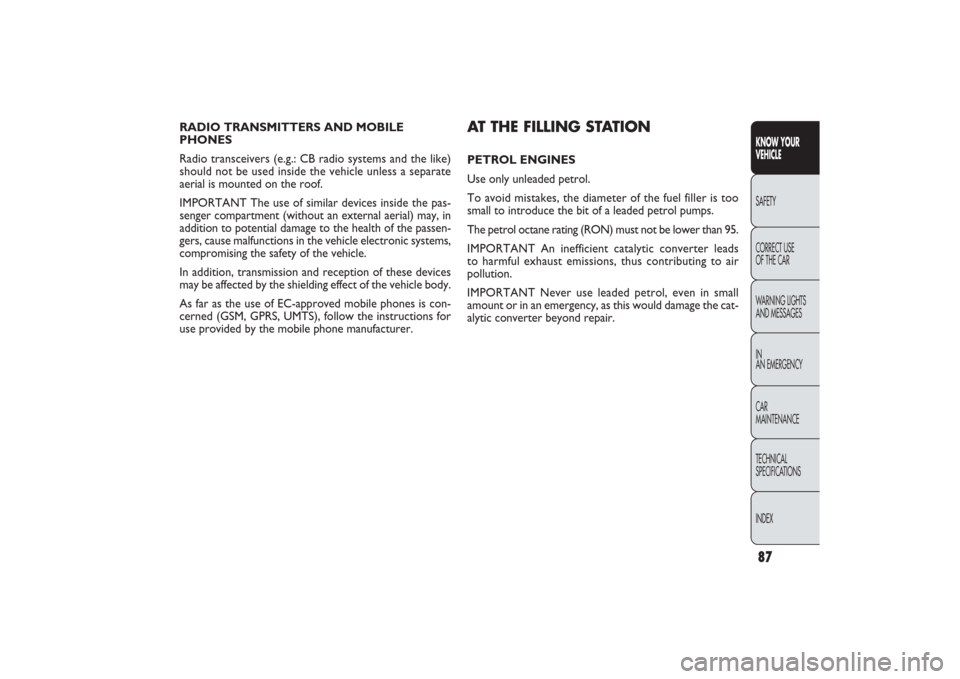
RADIO TRANSMITTERS AND MOBILE
PHONES
Radio transceivers (e.g.: CB radio systems and the like)
should not be used inside the vehicle unless a separate
aerial is mounted on the roof.
IMPORTANT The use of similar devices inside the pas-
senger compartment (without an external aerial) may, in
addition to potential damage to the health of the passen-
gers, cause malfunctions in the vehicle electronic systems,
compromising the safety of the vehicle.
In addition, transmission and reception of these devices
may be affected by the shielding effect of the vehicle body.
As far as the use of EC-approved mobile phones is con-
cerned (GSM, GPRS, UMTS), follow the instructions for
use provided by the mobile phone manufacturer.
AT THE FILLING STATIONPETROL ENGINES
Use only unleaded petrol.
To avoid mistakes, the diameter of the fuel filler is too
small to introduce the bit of a leaded petrol pumps.
The petrol octane rating (RON) must not be lower than 95.
IMPORTANT An inefficient catalytic converter leads
to harmful exhaust emissions, thus contributing to air
pollution.
IMPORTANT Never use leaded petrol, even in small
amount or in an emergency, as this would damage the cat-
alytic converter beyond repair.
87KNOW YOUR
VEHICLESAFETY
CORRECT USE
OF THE CAR
WARNING LIGHTS
AND MESSAGES
IN
AN EMERGENCY
CAR
MAINTENANCE
TECHNICAL
SPECIFICATIONS
INDEX
065-090 PANDA EN 7-10-2009 13:45 Pagina 87
Page 91 of 226
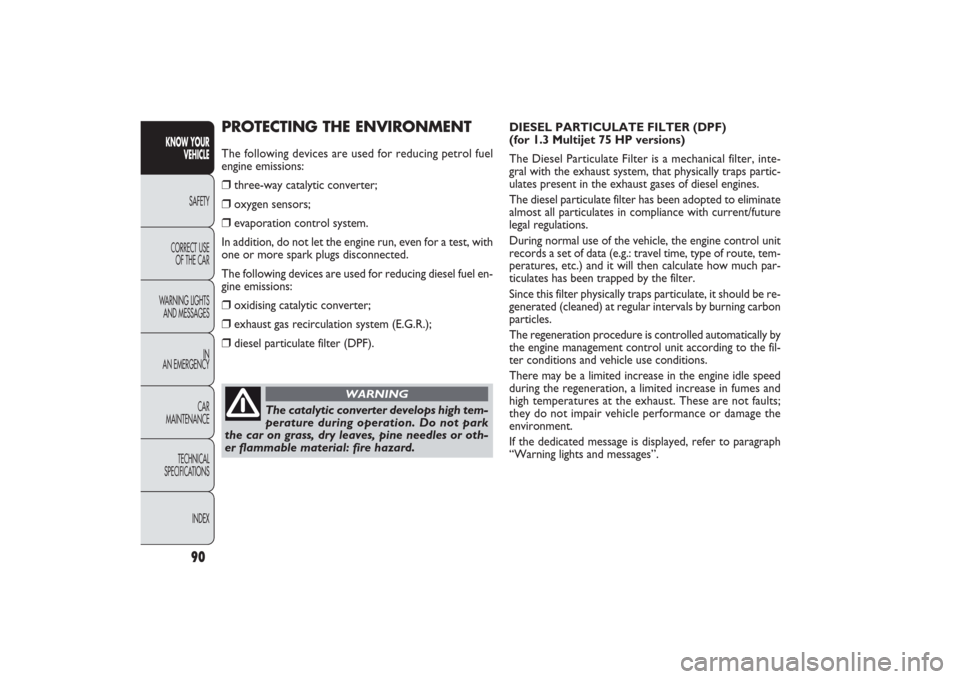
90
DIESEL PARTICULATE FILTER (DPF)
(for 1.3 Multijet 75 HP versions)
The Diesel Particulate Filter is a mechanical filter, inte-
gral with the exhaust system, that physically traps partic-
ulates present in the exhaust gases of diesel engines.
The diesel particulate filter has been adopted to eliminate
almost all particulates in compliance with current/future
legal regulations.
During normal use of the vehicle, the engine control unit
records a set of data (e.g.: travel time, type of route, tem-
peratures, etc.) and it will then calculate how much par-
ticulates has been trapped by the filter.
Since this filter physically traps particulate, it should be re-
generated (cleaned) at regular intervals by burning carbon
particles.
The regeneration procedure is controlled automatically by
the engine management control unit according to the fil-
ter conditions and vehicle use conditions.
There may be a limited increase in the engine idle speed
during the regeneration, a limited increase in fumes and
high temperatures at the exhaust. These are not faults;
they do not impair vehicle performance or damage the
environment.
If the dedicated message is displayed, refer to paragraph
“Warning lights and messages”.
KNOW YOUR
VEHICLE
SAFETY
CORRECT USE
OF THE CAR
WARNING LIGHTS
AND MESSAGES
IN
AN EMERGENCY
CAR
MAINTENANCE
TECHNICAL
SPECIFICATIONS
INDEX
PROTECTING THE ENVIRONMENTThe following devices are used for reducing petrol fuel
engine emissions:❒
three-way catalytic converter;
❒
oxygen sensors;
❒
evaporation control system.
In addition, do not let the engine run, even for a test, with
one or more spark plugs disconnected.
The following devices are used for reducing diesel fuel en-
gine emissions:
❒
oxidising catalytic converter;
❒
exhaust gas recirculation system (E.G.R.);
❒
diesel particulate filter (DPF).
The catalytic converter develops high tem-
perature during operation. Do not park
the car on grass, dry leaves, pine needles or oth-
er flammable material: fire hazard.
WARNING
065-090 PANDA EN 7-10-2009 13:45 Pagina 90
Page 112 of 226

111KNOW
YOUR VEHICLE
SAFETY
WARNING LIGHTS
AND MESSAGES
IN
AN EMERGENCY
CAR
MAINTENANCE
TECHNICAL
SPECIFICATIONS
INDEX
CORRECT USE OF THE CAR
STARTING PROCEDURE FOR PETROL
VERSIONS
Proceed as follows:❒
engage the handbrake;
❒
place the gearshifting lever in neutral;
❒
press the clutch pedal all the way down without touch-
ing the accelerator;
❒
turn the ignition key to
AVV
and let it go as soon as
the engine starts.
If the engine does not start at the first attempt, return
the ignition key to
STOP
before repeating starting.
STARTING THE ENGINEThe car is fitted with an electronic engine lock device:
if the engine fails to start, see the paragraph “The Fiat
CODE system” in section “Know your vehicle”.
The engine may be noisier during the first few seconds of
operation, especially after a long period of inactivity. This
characteristic feature of the hydraulic tappet system does
not compromise functionality or reliability: the system de-
vised for your car was designed to limit maintenance
interventions.
It is dangerous to let the engine run in en-
closed spaces. The engine consumes oxy-
gen and engine exhaust contains carbon dioxide,
carbon monoxide and other toxic gasses.
WARNING
CORRECT USE
OF THE CAR
We recommend that during the initial pe-
riod you do not drive to full car perfor-
mance (e.g.: excessive acceleration, long
journeys at top speed, sharp braking, etc.).When the engine is switched off never leave
the key into the ignition switch to prevent
useless current absorption from draining the
battery.
Remember that the servo-brake and pow-
er steering are not operational until the
engine has been started, therefore much effort
than usual is required on the brake pedal
and teering wheel.
WARNING
111-122 PANDA EN 7-10-2009 15:01 Pagina 111
Page 120 of 226
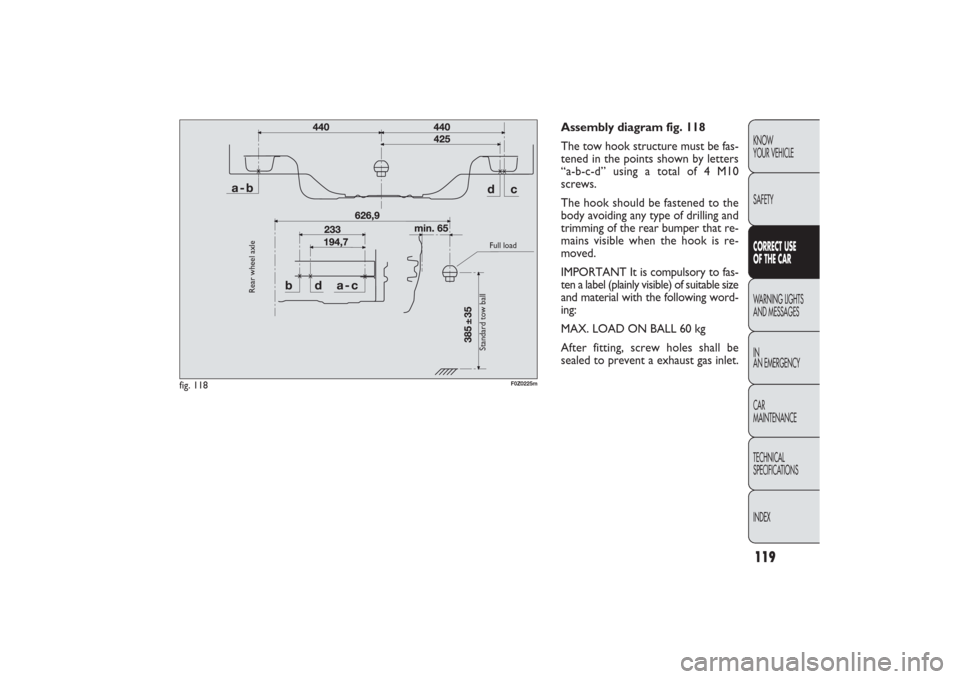
119KNOW
YOUR VEHICLE
SAFETYCORRECT USE
OF THE CARWARNING LIGHTS
AND MESSAGES
IN
AN EMERGENCY
CAR
MAINTENANCE
TECHNICAL
SPECIFICATIONS
INDEX
Assembly diagram fig. 118
The tow hook structure must be fas-
tened in the points shown by letters
“a-b-c-d” using a total of 4 M10
screws.
The hook should be fastened to the
body avoiding any type of drilling and
trimming of the rear bumper that re-
mains visible when the hook is re-
moved.
IMPORTANT It is compulsory to fas-
ten a label (plainly visible) of suitable size
and material with the following word-
ing:
MAX. LOAD ON BALL 60 kg
After fitting, screw holes shall be
sealed to prevent a exhaust gas inlet.
fig. 118
F0Z0225m
Rear wheel axle
Standard tow ball
Full load
111-122 PANDA EN 7-10-2009 15:01 Pagina 119
Page 121 of 226
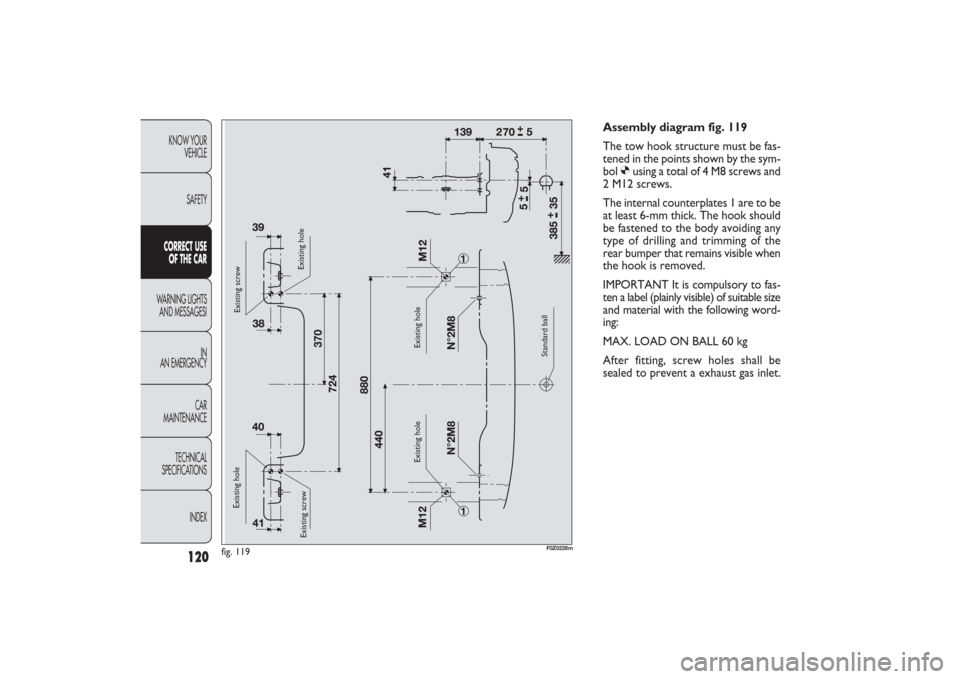
120
KNOW YOUR
VEHICLE
SAFETYCORRECT USE
OF THE CARWARNING LIGHTS
AND MESSAGESI
IN
AN EMERGENCY
CAR
MAINTENANCE
TECHNICAL
SPECIFICATIONS
INDEX
Assembly diagram fig. 119
The tow hook structure must be fas-
tened in the points shown by the sym-
bol
Ø
using a total of 4 M8 screws and
2 M12 screws.
The internal counterplates 1 are to be
at least 6-mm thick. The hook should
be fastened to the body avoiding any
type of drilling and trimming of the
rear bumper that remains visible when
the hook is removed.
IMPORTANT It is compulsory to fas-
ten a label (plainly visible) of suitable size
and material with the following word-
ing:
MAX. LOAD ON BALL 60 kg
After fitting, screw holes shall be
sealed to prevent a exhaust gas inlet.
fig. 119
F0Z0226m
Existing hole
Existing hole
Existing hole Existing hole
Standard ballExisting screw
Existing screw
111-122 PANDA EN 7-10-2009 15:01 Pagina 120
Page 127 of 226

126
KNOW YOUR
VEHICLE
SAFETY
CORRECT USE
OF THE CAR
WARNING LIGHTS
AND MESSAGES
IN
AN EMERGENCY
CAR
MAINTENANCE
TECHNICAL
SPECIFICATIONS
INDEX
CONTINUOUSLY ON: LOW ENGINE
OIL PRESSURE (red)
FLASHING: EXHAUSTED ENGINE OIL
(only Multijet versions with DPF – red)
When the key is turned to MAR the warning light comes
on, but should go out as soon as the engine is started.
Low engine oil pressure
The warning light will turn on constantly together with the
message on the display (for versions/markets where pro-
vided) when the system detects that the engine oil pres-
sure is too low.If the warning light
v
turns on when the
car is travelling (on certain versions to-
gether with the message on the display) stop the
engine immediately and contact a Fiat Dealership.
WARNING
Exhausted engine oil
(Multijet versions with DPF only)
The warning light will turn on flashing together with the
message on the display (for versions/markets where pro-
vided). Depending on the versions, the warning light flash-
ing modes are as follows:
– one minute every two hours;
– cycles of three minutes with intervals with the warning
light off for five seconds until the oil is changed.v
If the warning light comes on, the ex-
hausted engine oil should be changed as
soon as possible, never drive more than 500 km
from the first switching-on of this warning light.
If the above instructions are not complied with,
the engine could be severely damaged and the
warranty may decay. Please note also that the
switching on of this warning light does not depend
on the oil quantity in the engine; when the warn-
ing light flashes, never add oil.
WARNING
After the first indication, at each engine start up the warn-
ing light will continue flashing as above described until the
oil is changed. For those versions/markets where provid-
ed, the display shows a dedicated message together with
the warning light.
The flashing of the warning light should not be consid-
ered as as fault, rather simply informs the customer that
oil needs to be changed after a standard period of car util-
isation.
Remember that the deterioration of the engine oil is ac-
celerated by:
– mainly town use of the car which makes the DPF re-
generation process more frequent;
– use of the car for short journeys, preventing the engine
from reaching operating temperature;
– repeated interruptions to the regeneration process sig-
nalled by the DPF warning light coming on.
123-134 PANDA EN 7-10-2009 13:49 Pagina 126
Page 128 of 226
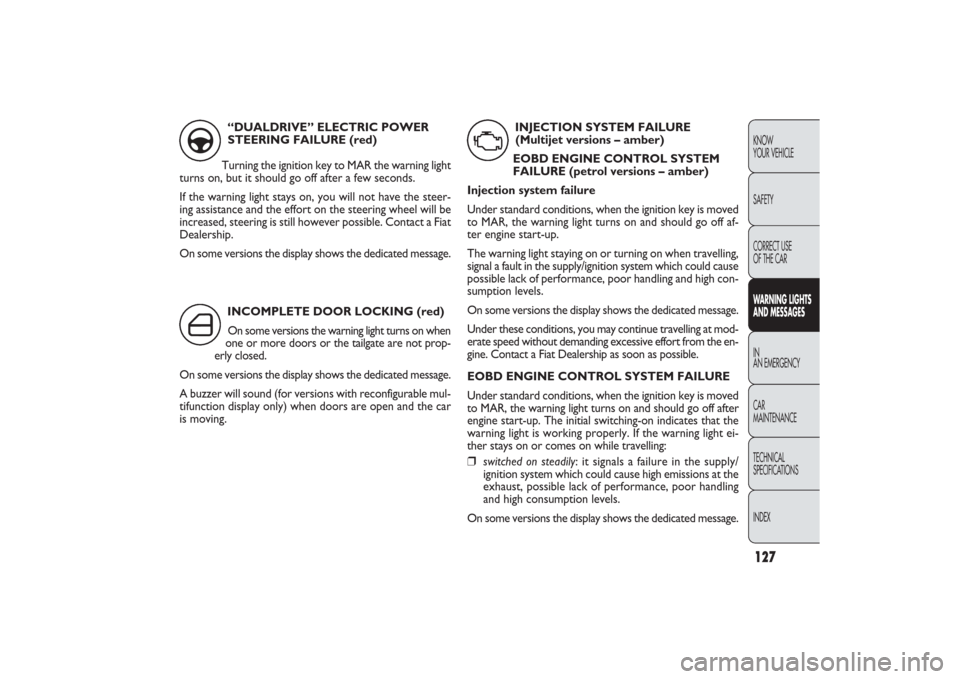
127KNOW
YOUR VEHICLE
SAFETY
CORRECT USE
OF THE CARWARNING LIGHTS
AND MESSAGESIN
AN EMERGENCY
CAR
MAINTENANCE
TECHNICAL
SPECIFICATIONS
INDEX
INJECTION SYSTEM FAILURE
(Multijet versions – amber)
EOBD ENGINE CONTROL SYSTEM
FAILURE (petrol versions – amber)
Injection system failure
Under standard conditions, when the ignition key is moved
to MAR, the warning light turns on and should go off af-
ter engine start-up.
The warning light staying on or turning on when travelling,
signal a fault in the supply/ignition system which could cause
possible lack of performance, poor handling and high con-
sumption levels.
On some versions the display shows the dedicated message.
Under these conditions, you may continue travelling at mod-
erate speed without demanding excessive effort from the en-
gine. Contact a Fiat Dealership as soon as possible.
EOBD ENGINE CONTROL SYSTEM FAILURE
Under standard conditions, when the ignition key is moved
to MAR, the warning light turns on and should go off after
engine start-up. The initial switching-on indicates that the
warning light is working properly. If the warning light ei-
ther stays on or comes on while travelling:
❒switched on steadily: it signals a failure in the supply/
ignition system which could cause high emissions at the
exhaust, possible lack of performance, poor handling
and high consumption levels.
On some versions the display shows the dedicated message. “DUALDRIVE” ELECTRIC POWER
STEERING FAILURE (red)
Turning the ignition key to MAR the warning light
turns on, but it should go off after a few seconds.
If the warning light stays on, you will not have the steer-
ing assistance and the effort on the steering wheel will be
increased, steering is still however possible. Contact a Fiat
Dealership.
On some versions the display shows the dedicated message.
g
INCOMPLETE DOOR LOCKING (red)
On some versions the warning light turns on when
one or more doors or the tailgate are not prop-
erly closed.
On some versions the display shows the dedicated message.
A buzzer will sound (for versions with reconfigurable mul-
tifunction display only) when doors are open and the car
is moving.
´
U
123-134 PANDA EN 7-10-2009 13:49 Pagina 127
Page 130 of 226

129KNOW
YOUR VEHICLE
SAFETY
CORRECT USE
OF THE CARWARNING LIGHTS
AND MESSAGESIN
AN EMERGENCY
CAR
MAINTENANCE
TECHNICAL
SPECIFICATIONS
INDEX
EOBD ENGINE CONTROL SYSTEM FAILURE
Under standard conditions, when the ignition key is moved
to MAR, the warning light turns on and should go off after
engine start-up. The initial switching-on indicates that the
warning light is working properly. If the warning light ei-
ther stays on or comes on while travelling:
❒switched on steadily: it signals a failure in the supply/
ignition system which could cause high emissions at the
exhaust, possible lack of performance, poor handling
and high consumption levels.
On some versions the display shows the dedicated message.
Under these conditions, you may continue travelling at
moderate speed without demanding excessive effort from
the engine. Prolonged use of the car with the warning light
on may cause damages. Contact a Fiat Dealership as soon
as possible. The warning light goes off if the failure disap-
pears, but it is still stored by the system.
❒flashing: it indicates the possibility of damage to the cat-
alytic converter (see “EOBD system” in section “Know
your vehicle”).
If the warning light flashes, it is necessary to release the ac-
celerator pedal to lower the speed of the engine until the
warning light stops flashing; continue the journey at mod-
erate speed, trying to avoid driving conditions that may
cause further flashing and contact Fiat Dealership as soon
as possible.
If, turning the ignition key to MAR, the
warning light Udoes not turn on or if it
turns on steadily or flashing when travelling
(on certain versions together with the message on
the display), contact a Fiat Dealership as soon as
possible. The operation of the warning light Umay
be checked by the traffic control authorities using
specific devices. Always comply with the traffic
regulations in force in the country where you are
driving.
123-134 PANDA EN 7-10-2009 13:49 Pagina 129
Page 171 of 226

●●●● ● ●●●●
●●●● ● ●●●●
●●●● ● ●●●●
●●●● ● ●●●●
●●●● ● ●●●●
●●●
●●●● ● ●●●●
●●●● ● ●●●●
●
●● ●●
●● ●●
●● ●●
●●20 40 60 80 100 120 140 160 180
SCHEDULED SERVICING PROGRAMMEThese coupons have to be carried out every 20,000 km
Thousands of km
Check tyre condition/wear and, if necessary, adjust
pressure
Check lighting system operation (headlights, direction indicators,
hazard warning lights, passenger’s compartment lights, boot lights, instrument panel warning lights, etc.)Check windscreen wiper/washer operation, adjust nozzlesCheck windscreen/rear window blade position/wearCheck front disc brake pad conditions and wearCheck rear drum brake linings conditions and wear
Condition visual check: bodywork exterior, underbody
protection, pipes and hoses (exhaust – fuel supply system
– braking system), rubber elements (boots – sleeves – bushes – etc...)
Check cleanliness of bonnet and boot locks, as well as cleanliness and lubrication of linkages
Check tension and conditions of various accessory drive belts (except for engines with automatic tensioners)Visually inspect conditions of the accessory drive beltsCheck and adjust tappet clearance (petrol versions)Check and adjust handbrake lever stroke Check anti-evaporation system (petrol versions)
INDEX TECHNICAL
SPECIFICATIONSCAR
MAINTENANCEIN
AN EMERGENCY WARNING LIGHTS
AND MESSAGESCORRECT USE
OF THE CARSAFETYKNOW
YOUR VEHICLE
170
169-190 PANDA EN 7-10-2009 14:14 Pagina 170
Page 172 of 226
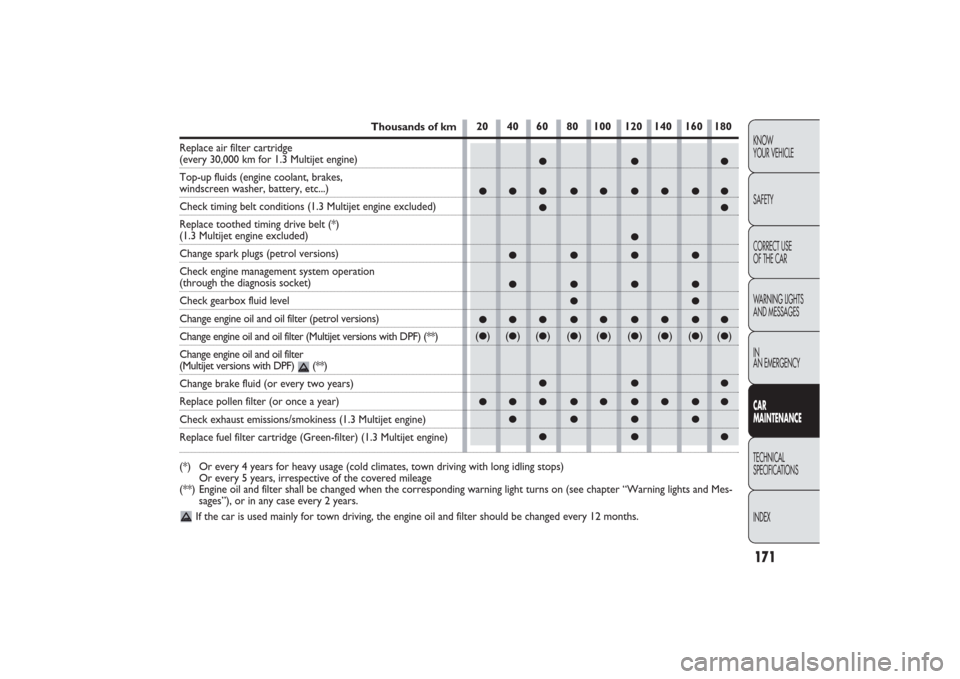
●●●
●●● ●● ●● ●●
●●
●
●●●●
●●●●
●●
●●● ●● ●● ●●
(●)(
●)(
●)(
●)(
●)(
●)(
●)(
●)(
●)
●●●
●●● ●● ●● ●●
●●●●
●●●
20 40 60 80 100 120 140 160 180
Thousands of km
Replace air filter cartridge
(every 30,000 km for 1.3 Multijet engine)
Top-up fluids (engine coolant, brakes, windscreen washer, battery, etc...)Check timing belt conditions (1.3 Multijet engine excluded)
Replace toothed timing drive belt (*) (1.3 Multijet engine excluded)Change spark plugs (petrol versions)
Check engine management system operation (through the diagnosis socket)Check gearbox fluid levelChange engine oil and oil filter (petrol versions)Change engine oil and oil filter (Multijet versions with DPF) (**)
Change engine oil and oil filter (Multijet versions with DPF) (**)Change brake fluid (or every two years)Replace pollen filter (or once a year)Check exhaust emissions/smokiness (1.3 Multijet engine)Replace fuel filter cartridge (Green-filter) (1.3 Multijet engine)
(*) Or every 4 years for heavy usage (cold climates, town driving with long idling stops)
Or every 5 years, irrespective of the covered mileage
(**) Engine oil and filter shall be changed when the corresponding warning light turns on (see chapter “Warning lights and Mes-
sages”), or in any case every 2 years.
If the car is used mainly for town driving, the engine oil and filter should be changed every 12 months.
INDEX TECHNICAL
SPECIFICATIONSCAR
MAINTENANCEIN
AN EMERGENCY WARNING LIGHTS
AND MESSAGES CORRECT USE
OF THE CAR SAFETY KNOW
YOUR VEHICLE171
169-190 PANDA EN 7-10-2009 14:14 Pagina 171